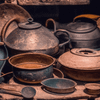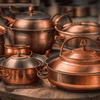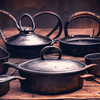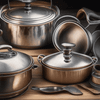Cooking is an integral part of human civilization, and the tools we use to prepare meals have evolved significantly over time. Among the essential utensils in every kitchen, pots and pans hold a special place. These versatile cooking vessels have a rich history that spans across cultures and continents, offering insights into the development of culinary practices and the evolution of technology. Let's embark on a journey to uncover the fascinating origins of cookware.
Ancient Beginnings: Earthenware and Clay Pots
The history of pots and pans dates back thousands of years. The earliest known cookware can be traced to ancient civilizations that used natural resources to fashion rudimentary cooking vessels. In many regions, earthenware and clay pots were the primary means of cooking. These pots were made by shaping clay and baking it in open fires or kilns, resulting in durable and heat-resistant vessels. Archaeological discoveries indicate that ancient Egyptians, Greeks, and Romans were skilled in pottery-making, creating pots that played a vital role in their culinary traditions.
Advancements in Metalwork: Copper and Bronze
With the discovery and utilization of metals, cookware took a significant leap forward. Copper and bronze were among the first metals used in the production of pots and pans. Copper, with its excellent heat conductivity, allowed for more precise temperature control during cooking. Bronze, an alloy of copper and tin, offered even greater durability. These advancements revolutionized culinary practices, enabling people to cook more efficiently and with greater precision.
The Rise of Iron: Cast Iron Cookware
The Iron Age marked another milestone in the history of cookware. Cast iron, with its exceptional heat retention and distribution properties, became increasingly popular. The Chinese were pioneers in the production of cast iron cookware, developing intricate molds and perfecting the art of iron casting. As trade routes expanded, cast iron cookware made its way to different parts of the world, transforming the way food was prepared and cooked.
Modern Innovations: Stainless Steel and Nonstick Coatings
In the 20th century, the invention of stainless steel revolutionized the cookware industry. Stainless steel pots and pans offered durability, resistance to corrosion, and ease of cleaning, making them a staple in kitchens worldwide. Additionally, the development of nonstick coatings brought about a new era of convenience and reduced the need for excessive oil or butter during cooking.
Contemporary Cookware: An Array of Options
Today, the options for cookware are vast and diverse. From traditional materials like copper and cast iron to modern innovations such as ceramic and titanium, there is a pan for every culinary need. Specialized cookware, such as woks, Dutch ovens, and sauté pans, cater to different cooking techniques and styles. The use of advanced materials, ergonomic designs, and technological advancements continue to shape the cookware industry, ensuring that home cooks and professional chefs alike have access to the best tools for their culinary creations.
In conclusion, the history of pots and pans is a testament to human ingenuity and our ever-evolving relationship with food. From humble earthenware pots to the sleek stainless steel pans of today, cookware has come a long way. Exploring the origins of cookware allows us to appreciate the rich heritage behind these essential kitchen tools while understanding how they have shaped the way we cook and enjoy meals throughout history.
Don't forget to visit the recipes section to find delicious recipes and helpful tips for using your cookware collection.




















